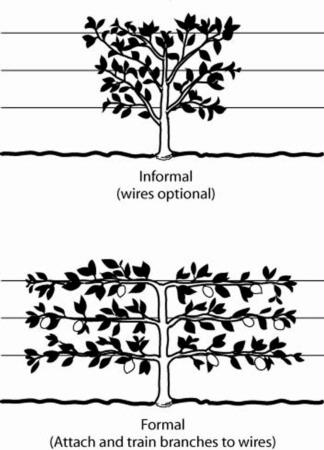
The espalier technique was developed centuries ago in France. Gardeners there used rope to shape fruit trees and found that the trees produced a good crop. It seems that limbs trained horizontally produce more fruit than branches pointed up. However,the method does take more work and planning than an orchard layout.
Dwarf figs, apples, pears and citrus are the most common fruit trees grown as espalier. Other fruit trees are more difficult to train in this way.
You can espalier a tree against a wall unless you are in a very warm climate. In that case, the heat reflected by the wall might cause fruit and leaves to burn.
You will need to set up a trellis system on which the trees can grow. Be sure to leave enough space to move behind the trees so you can prune them easily. Then you need to install posts tall enough to support the mature trees. Seven to eight feet is suggested. Place the first wire about three feet above the ground and then one foot apart after that.
At the nursery, select trees with lots of branching. You are going to cut off most of the branches and direct the remainder along the trellis wire. If you can't find such a tree, start with a whip (a young, slender, non-branching trunk).Another alternative is to prune off all the trunk's branches and direct the new, flexible growth along the wires.
The espalier method is not something you do once to each tree and then you're done. Itis a process. It involves constant training and pruning to get branches growing in the right direction.
I suggest purchasing bare-root fruit trees because they are much less expensive than container trees.When you plant them for espalier, you use the same methods that apply to any bare-root tree. Site the trees close to the trelliswith at least six feet between each tree.
Dig a hole wide and deep enough to accommodate all the roots. You can prune some of the root tips off before planting.Create a mound inside the planting hole. Set the tree on the mound and spread the roots evenly around, then take a look. Make sure that when you back fill the planting hole, the tree is no deeper than it was before. Be sure the graft union (where the scion is grafted to the rootstock) is above the soil line.
Remove the tree and water the hole well. Then place the tree on the mound again and refill the hole with soil. Water again. You want the soil to go into all the nooks and crannies. Stomp on the soil to compact it.
Trim all branches that you cannot easily train to the wire. Tie branches to the wire with a plastic tie. Trim back the growing tip to buds coming out the sides at the next highest wire.
You will need to continue this training throughout the life of your fruit trees.
Master Gardeners are volunteers who help the University of California reach the gardening public with home gardening information. U. C. Master Gardeners of Napa County ( http://ucanr.org/ucmgnapa/) are available to answer gardening questions in person or by phone, Monday, Wednesday and Friday, 9 a.m. to Noon, at the U. C. Cooperative Extension office, 1710 Soscol Avenue, Suite 4, Napa, 707-253-4143, or from outside City of Napa toll-free at 877-279-3065. Or e-mail your garden questions by following the guidelines on our web site. Click on Napa, then on Have Garden Questions? Find us on Facebook under UC Master Gardeners of Napa County.